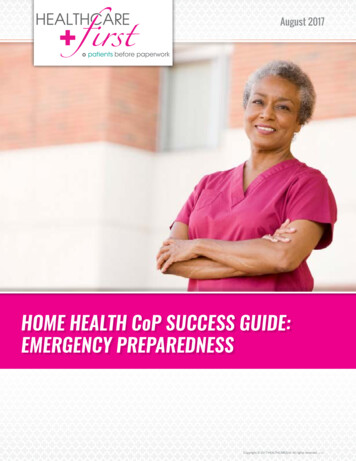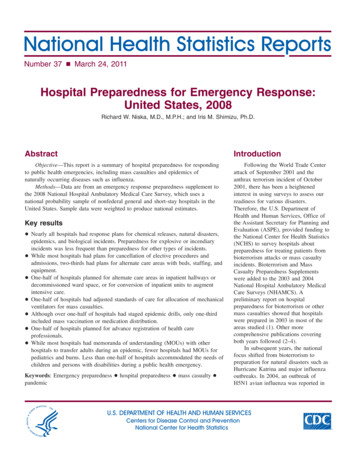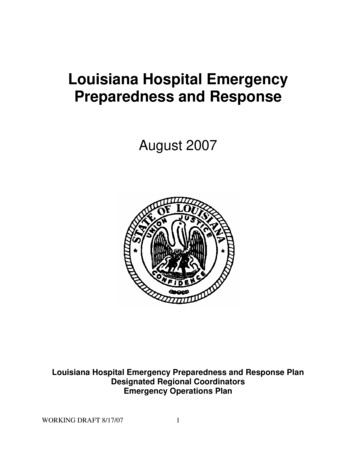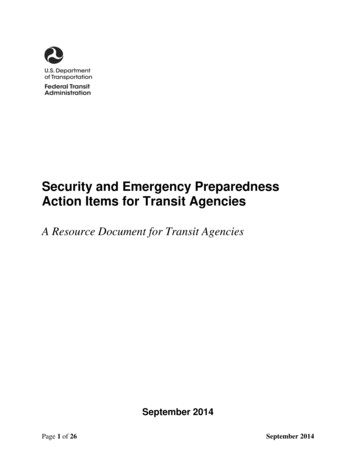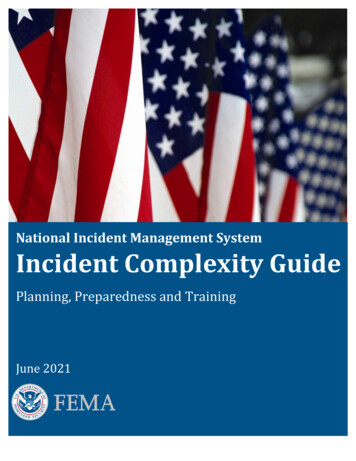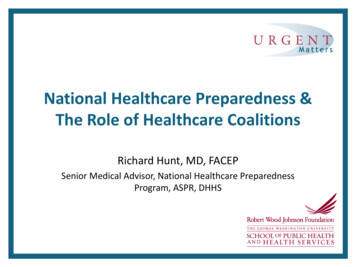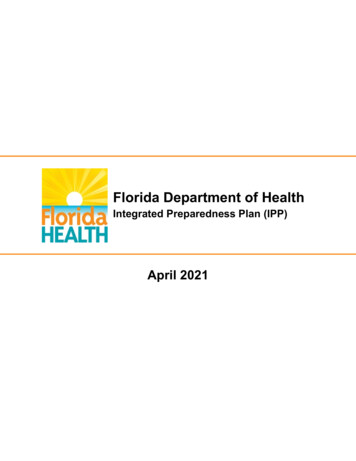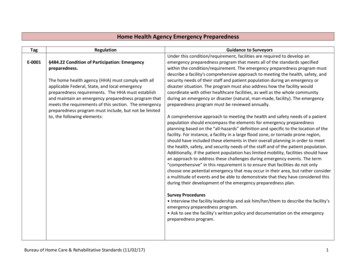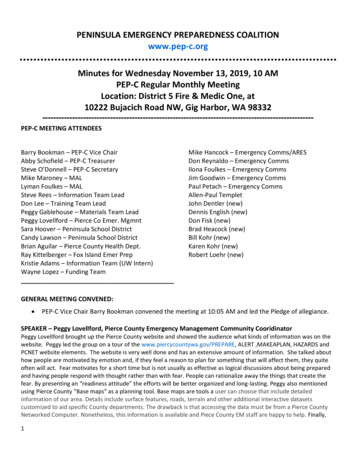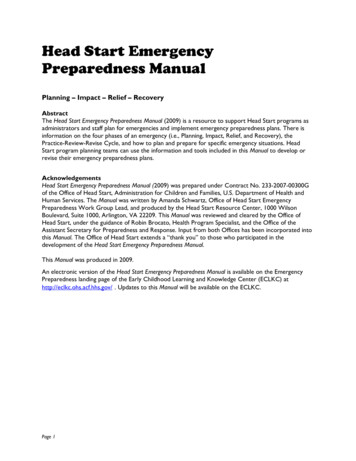
Transcription
Head Start EmergencyPreparedness ManualPlanning – Impact – Relief – RecoveryAbstractThe Head Start Emergency Preparedness Manual (2009) is a resource to support Head Start programs asadministrators and staff plan for emergencies and implement emergency preparedness plans. There isinformation on the four phases of an emergency (i.e., Planning, Impact, Relief, and Recovery), thePractice-Review-Revise Cycle, and how to plan and prepare for specific emergency situations. HeadStart program planning teams can use the information and tools included in this Manual to develop orrevise their emergency preparedness plans.AcknowledgementsHead Start Emergency Preparedness Manual (2009) was prepared under Contract No. 233-2007-00300Gof the Office of Head Start, Administration for Children and Families, U.S. Department of Health andHuman Services. The Manual was written by Amanda Schwartz, Office of Head Start EmergencyPreparedness Work Group Lead, and produced by the Head Start Resource Center, 1000 WilsonBoulevard, Suite 1000, Arlington, VA 22209. This Manual was reviewed and cleared by the Office ofHead Start, under the guidance of Robin Brocato, Health Program Specialist, and the Office of theAssistant Secretary for Preparedness and Response. Input from both Offices has been incorporated intothis Manual. The Office of Head Start extends a “thank you” to those who participated in thedevelopment of the Head Start Emergency Preparedness Manual.This Manual was produced in 2009.An electronic version of the Head Start Emergency Preparedness Manual is available on the EmergencyPreparedness landing page of the Early Childhood Learning and Knowledge Center (ECLKC) athttp://eclkc.ohs.acf.hhs.gov/ . Updates to this Manual will be available on the ECLKC.Page 1
Table of ContentsPreface . iiiA Story of Emergency Preparedness in Head Start . ivChapter I: Introduction. 1Overview.1What Is Emergency Preparedness? .4How Do Levels of Impact Affect Planning? .5Why Is Emergency Preparedness Important?.6What Are the National Standards Related to Emergency Preparedness? .7What Is Head Start’s Role? .7What Have We Learned from Disasters? .8September 11, 2001 .9The Gulf Coast Hurricanes of 2005. 10Other Local Emergencies: Fire . 12Chapter II: Planning Phase . 16Emergency Preparedness Program Self-Assessment. 16What Is Planning? . 18What Are the Components of a Strong Plan?. 20What Are the Systems To Consider in Your Program? . 21What Are the Services To Consider in Your Program? . 26How Do Programs Develop Plans?. 30What Role Does Personal Preparedness Play in Program Planning?. 32What Does Planning Look Like in Head Start Programs? . 33Chapter III: Impact Phase. 35What is Impact? . 35What Priorities Does Your Program Need To Consider?. 35What Are Decision Trees? . 36How Is the Plan Implemented?. 38What Does the Impact Phase Look Like in Head Start Programs? . 40Chapter IV: Relief Phase . 42What Is Relief? . 42How Do Programs Develop Action Checklists?. 44How Is the Plan Implemented During the Relief Phase? . 46What Does the Relief Phase Look Like in Head Start Programs? . 47Chapter V: Recovery Phase . 49What Is Recovery?. 49What Priorities Does Your Program Need To Consider?. 50How Do Programs Develop Long-Term Recovery Plans? . 55How Is the Plan Implemented During the Recovery Phase? . 56What Does Recovery Look Like in Head Start Programs? . 57Chapter VI: Practice-Review-Revise Cycle . 60What Is the Practice–Review–Revise Cycle?. 60How Is Your Plan Communicated to the Head Start Community? . 62What Are Some Suggestions for Emergency Preparedness Training? . 63Page i
Conclusion. 64Appendix A: Information Regarding Specific Emergencies. 65Natural Disasters . 66Earthquake. 67Extreme Heat . 76Fire . 80Flood. 85Hurricane. 89Landslide and Mudslide. 95Thunderstorms and Lightning. 98Tornado . 101Volcano . 107Wildfire . 111Winter Storm and Extreme Cold. 116Health Emergencies . 119Novel H1N1 (Swine Flu). 120Widespread Disease Outbreak . 122Technical Hazards . 124Center-Based Chemical Emergency . 125Hazardous Materials Incident. 128Terrorism and Random Acts of Violence. 131Community Violence . 132Family Violence . 134Terrorism . 136Appendix B: Tools for Emergency Preparedness Planning . 142Appendix C: Fact Sheets. 177Appendix D: Head Start Resources. 202Page ii
PrefaceFrom time to time, communities around the country face catastrophic natural and man-madedisasters. The wildfires in California, the hurricanes on the Gulf Coast, the floods in theMidwest, and the attacks of September 11, 2001, are examples of disasters in recent years thatgarnered national attention. They also highlight the fact that an emergency can occur suddenly,with little or no warning; deprive families of even the most basic food and shelter; and havesignificant social and emotional impacts that linger long after the event.Head Start can play an important role in supporting children and families in their localcommunities before, during, and after an emergency. Toward that end, all Head Start programsshould have an effective, well-practiced emergency preparedness plan in place.The Office of Head Start has developed this Head Start Emergency Preparedness Manual toprovide Head Start programs with tools and resources to guide their planning process. TheManual provides information on the emergency preparedness cycle, which includes Planning,Impact, Relief and Recovery. Appendices include resources from the Federal EmergencyManagement Agency and the Centers for Disease Control and Prevention on natural disasters,health emergencies, terrorism and random acts of violence, and technical hazards.This Manual is available online on the Early Childhood Learning and Knowledge Center(ECLKC) at http://eclkc.ohs.acf.hhs.gov/. Future updates to the Manual will be available on theECLKC.Page iii
A Story of Emergency Preparedness in Head StartDelivering high-quality services to Early Head Start childrensheltered in a closet Yes, it’s true. Until yesterday, I’d never experienced the delivery of high-quality services to infants andtoddlers being sheltered in a closet. During a Training and Technical Assistance (T/TA) session with agroup of Early Head Start (EHS) staff, an administrator from the elementary school popped her headinto our room to say that a tornado warning was about to go into effect. The teachers in my sessioncalmly stood up and headed back to their classrooms. The children had just gotten up from their napsand were having a snack when the sirens started and the lights went out.By the time I got to the classroom, the teachers had taken their children into the storage closet adjacentto their room. They shared the space with a group of preschoolers from the special education classroomnext door. While the space was very tight, the EHS teachers had arranged themselves so that theywere nestled together with their primary caregiving groups. One staff member was off to the side with achild who had recently transitioned from a home-based program to a center and was still adjusting tobeing with a group of children.After settling in and using the light from their cell phones, the EHS teachers and manager began to singsongs and engage the children in finger plays. Later, they invited the children to play games with a fewtoys they had available to them. The mood was calm and comforting. After an hour and a half, theemergency was declared over and everyone returned to their classrooms. Parents arrived and, whilenervous about the incredible rain that continued to pour down, they were reassured by the sight of thecontented children with their nurturing caregivers.What an amazing experience – the effect of which did not end that day. I spoke with the EHSmanager the next morning. Although they still did not have power at the school, her incredible staffcame to work anyway. It appeared to be another day in EHS; one filled with possibilities. When youhave good staff who are prepared for an emergency and ready to make any adjustments necessary,even working in a closet, children can continue to receive the quality care they need.Contributed by Sarah Minteer Semlak, Ph.D.Early Childhood ConsultantPage iv
Chapter I: IntroductionThe Chinese use two brush strokes to write the word “crisis.” One brush strokestands for danger; the other for opportunity. In a crisis, be aware of the danger –but recognize the opportunity.Richard Nixon – 37th President of the United Stateswho opened relations to China by visiting in1972OverviewEmergencies occur suddenly and disastrously and can leave you feeling overwhelmed andpowerless. Being prepared can lessen some of these feelings by allowing you to better protectyourself, families, and property, and to help others who may be affected. By preparing foremergency situations, you can empower your staff and families to make decisions and takeappropriate actions during an emergency.Planning is a key component of your current systems and services in Head Start. Your programcreates, maintains, and revises plans on service delivery to children and families. These planssatisfy requirements of the Head Start Program Performance Standards and serve as workingdocuments to guide everyday functioning. An emergency preparedness plan is not new; rather,it builds upon existing program plans.Your program has fire drills, emergency weather procedures, and other necessary plans for avariety of emergencies. However, has your program considered all of the possible emergenciesthat might occur? In recent years, emergencies related to illness, violence, and severe weatherhave occurred when programs never expected them. Therefore, it is critical to ask some keyquestions before determining that your plan is complete. Does your plan: Consider specific emergencies and their varying levels of consequence? Include what needs to happen before, during, and after the emergency? Include perspectives from different members of your Head Start community and thecommunity at large? Fit into the broader community emergency preparedness plans? Include regularly scheduled opportunities for practice, review, and revision?Page 1
Top Five Reasons to Prepare1. Emergencies, large and small, occur in every community, even yours.2. You are already doing it! Every program prepares plans to meet requirements of the Head Start ProgramPerformance Standards.3. As a member of your community, you participate in local planning efforts. Your emergency preparedness plansimply complements these efforts by focusing on how your program fits into the community plan.4. Your input is essential to make a plan that works. Administrators, staff, family members, and members of thecommunity at large collaborate together.5. Emergency preparedness is a dynamic planning process of practice, review, and revision that is essential toprogram excellence.Comprehensive emergency preparedness plans consider these questions to ensure thateveryone in the Head Start community is equipped to handle a possible emergency. Byconsidering the possibilities and planning several courses of action, you can help to ensure thateveryone in the Head Start community is equipped to handle what may happen – even whenloss is inevitable. The more prepared you are, the more likely you are to reduce losses and torebuild faster after a loss. By going step-by-step through each phase of an emergency (i.e.,Planning, Impact, Relief, and Recovery), you enable your program to build a plan that iscomprehensive, collaborative, and effective.The Head Start Emergency Preparedness Manual has been organized to support you as youcreate, practice, revise, and implement emergency preparedness plans. Each phase is discussedin greater detail throughout the Manual, including “how-to” suggestions for planning. You canread from the beginning to the end or go directly to the sections that are most relevant to you.Ultimately, each section offers comprehensive information to help your program prepare forand manage an emergency.Though it may seem daunting at first, your program can work through these steps in ways tohelp you succeed. You may choose to plan for one type of disaster at a time or work phase-byphase. You do not have to do it all at once! Getting started is the most important. The finalresult is a comprehensive, effective emergency preparedness plan.This Manual offers guidance on how to reduce the confusion, helplessness, and shock you mightfeel and encounter in others when an emergency occurs. When reviewing the plans andprocedures described in this Manual, carefully consider whether adaptations or special supportsare needed to protect the safety of infants and toddlers, and individuals with disabilities. Involveyour infant-toddler specialists, disabilities services coordinator, parents of infants, toddlers, andchildren with disabilities, and community partners. Structural changes to your facilities need tobe made in consultation with your landlord or local management company.Page 2
Finally, some Editor’s Notes:1. The term “emergency” is defined by the Federal Emergency Management Agency(FEMA) as “any unplanned event that can cause deaths or significant injuries toemployees, customers or the public, or that can shut down your business, disruptoperations, cause physical or environmental damage, or threaten the facility’s financialstanding or image”( http://www.fema.gov/business/guide/index.shtm ). In this Manual, “emergency” is usedinterchangeably with “disaster.”2. This Manual describes the four phases of an emergency (i.e. Planning, Impact, Relief,Recovery). Each one of these phases includes a planning component which is highlightedin the chapter. The resources in the Appendices will help you plan for each phase.3. The URL addresses listed in this Manual are current as of its publication. However,when Web sites are updated, pages may be moved or no longer available. If a Web sitethat you are trying to access is no longer available, contact the organization directly forassistance.4. Many of the Federal and national organizations cited in this Manual also provideemergency preparedness information in languages other than English. For example: FEMA’s Web site is offered in Cambodian, Croatian, French, Haitian-Creole,Hmong, Simplified Chinese, Traditional Chinese, Italian, Laotian, Russian, Spanish,Tagalog, Tigrinya, Vietnamese, and other languages tm. The Spanish-language version of the Centers for Disease Control and PreventionWeb site (Centros para el Control y la Prevención de Enfermedades) is available athttp://www.cdc.gov/spanish/. The Spanish-language version of the American Red Cross Web site (Cruz RojaAmericana) is available at http://www.cruzrojaamericana.org/index.asp.Note: In an emergency situation, staff from the Administration for Children and Families (ACF) Regional Officeimplement their Continuity of Operations Plan (COOP). To support programs and maintain services to childrenand families, the Regional Office staff assesses damage; assigns and activates necessary teams of staff toneeded areas; and if necessary, relocates Regional Office staff until normal operations can resume. This ensuresthat the Regional Office is able to support your program in times of emergency and ensures continuity for all otherprograms, affected or unaffected.Page 3
What Is Emergency Preparedness?At times, Head Start staff, children, and families are faced with the unexpected. Almost everyday, there is a news story about an emergency that affects individuals, families, towns, cities, orregions. Appearing suddenly or with minimal warning, an emergency can rob staff and families oftheir basic necessities, such as food and shelter. An emergency can take many forms: terrorismand random acts of violence, health emergencies, and natural disasters. Events, such as 9/11,Hurricane Katrina, California wildfires, Midwestern tornadoes, and pandemic flu outbreaksunderscore the critical importance of preparing Head Start programs to respond appropriatelyand quickly to emergencies.Emergency preparedness is the ability to react appropriately to a disaster. The EmergencyPreparedness Cycle consists of four phases: Planning, Impact, Relief, and Recovery. As seen inFigure 1, the four phases occur in a logical order to support program actions in preventing andcoping with the consequences of an emergency situation. Understanding the phases helps youplan what your program can do before, during, and after an emergency. This Manual providesguidance on how to plan for each phase.The Emergency Preparedness Cycle includes: Planning, Impact, Relief, and RecoveryNote: In this Manual, “planning” refers to “mitigation” and “preparedness” as used by emergencypreparedness professionals. They also group “impact” and “relief” into a “response” phase.The Planning Phase assesses emergencies that might occur, identifies preventative measuresto reduce risk, and develops a broad framework for your program to use.The Impact Phase begins during the moments when you are alerted to an impendingemergency and when the emergency actually occurs. Your planning efforts detail whatindividuals are expected to do, outlining the difficult decisions so others can simply act.Next, your program enters the Relief Phase. These are the hours, days, or weeks after anemergency occurs when efforts are focused on food, water, shelter, and the safety of thoseaffected. Your plan specifies activities to meet these basic needs.Finally, during the weeks, months, and years (in extreme cases) of the Recovery Phase, yourprogram resumes services. Your program determines long-term plans for assisting communitymembers in returning to their everyday lives by coping with losses resulting from theemergency.After you plan for each of these phases, revisit each phase through the Practice-ReviewRevise Cycle to ensure that your emergency preparedness plan is comprehensive, effective,and well-implemented.Planning is an ongoing process. Your emergency preparedness plan is never complete; it is aworking document. By regularly revisiting your plan, you ensure that key members of thePage 4
community know the plan, improve it with their expertise, and can implement the plan ifnecessary.How Do Levels of Impact Affect Planning?A disaster can have a widespread impact on a community. As indicated in Figure 2, disasters canaffect an individual child or family, a program, a neighborhood, a state, or an entire region. Ahouse fire is a disaster that might only affect a child and family, while a hurricane may impact anentire state or region.Intensity of Impact. When an emergency affects larger areas and more people, comprehensiveand collaborative emergency preparedness planning is essential.Head Start programs can: Collaborate with community organizations to implement an organized response to emergencies; Support their staff in developing personal plans so that staff are reassured that their families and friends are safe;Develop strong communication systems for all staff, families, and other community members;Offer shelter to displaced and homeless families;Provide mental health support necessary to assist children, families, and staff to cope during and after crisis;Collect basic necessities to relieve the sudden needs of family and staff; andMaintain collaborations and resources necessary to help families rebuild their lives.Help families, staff, and volunteers prepare for an emergency;Offer shelter and support during an emergency if their building is still safe;Link families with needs to other community agencies that can help, such as the Red Cross and Salvation Army;andOpen their doors to new families who have fled emergencies and offer expanded services to those in need.A disaster’s overall impact is important to keep in mind when planning each phase of theemergency preparedness cycle. Focusing on the level of impact is key when planning forevacuation or sheltering-in-place; assessing and compiling resources; and preparing communitymembers mentally and physically to cope with emergencies. Additionally, it is important toconsider the possible duration of the emergency, as well as the duration of each phase of theemergency.Emergency preparedness has gained national attention since the terrorist attacks of 2001 andthe Gulf Coast hurricanes of 2005; yet, it has always been a concern for Head Start programs.Emergency preparedness is the process by which you, as a Head Start community, work toconsider what could happen and what to do if it does. As you work through the differentemergencies that might occur and make decisions about how to react in each phase, you offerprograms, families, and community partners ways to minimize potential trauma in their lives.Page 5
Why Is Emergency Preparedness Important?Emergency situations arise suddenly and can be devastating to programs and communities.When programs prepare in advance, the negative effects of an emergency can be reduced.While you may not be able to anticipate everything that might happen, comprehensive planningfor each phase of an emergency allows you the peace of mind needed to help children, families,and staff. In addition, preparation allows you to resume services promptly and support thecommunity at large.According to the Federal Emergency Management Agency (FEMA): Being prepared can reduce fear, anxiety, and losses that accompany disasters.Communities, families, and individuals need to know what to do in the event of a fireand where to seek shelter during a tornado. They need to be ready to evacuate theirhomes and buildings and take refuge in public shelters and know how to care for theirbasic medical needs. By acting in advance, people can reduce the impact of disasters (e.g., flood proofing,elevating a home or moving a home or building out of harm’s way, securing items thatcould shake loose in an earthquake) and sometimes avoid the danger completely.(FEMA, Are You Ready? Why Prepare, http://www.fema.gov/areyouready/why prepare.shtm)A sound emergency preparedness plan helps your program to respond appropriately andquickly to circumstances that occur, thereby reducing risk to everyone within your Head Startcommunity.Recognizing the importance of emergency preparedness, the Improving Head Start for SchoolReadiness Act of 2007 Section 649 (m): Program Emergency Preparedness (Appendix D)requires that the Secretary of Health and Human Services prepare a report to Congress on theemergency preparedness of Head Start programs, including Early Head Start, to large-scaleemergencies. Recommendations are to include improvements to preparedness and responsecapabilities, procedures for informing and communicating with families, staff trainings, andcoordination among Federal, state, and local emergency management agencies.Page 6
What Are the National Standards Related to Emergency Preparedness?Developed by the American Academy of Pediatrics, the American Public Health Association,and the National Resource Center for Health and Safety in Child Care, the Emergency/DisasterPreparedness for Child Care Programs: Caring for Our Children National H
This Manual was reviewed and cleared by the Office of Head Start, under the guidance of Robin Brocato, Health Program Specialist, and the Office of the Assistant Secretary for Preparedness and Response. Input from both Offices has been incorporated into this Manual. The Office of Head Start extends a "thank you" to those who participated in the
